When we talk about the German Shepherd Dog, there are three things that
come to mind - breed characteristics, type and balance. Before we discuss
about the breed, we must know how this breed developed and the reason
behind it.
When the breed�s founding father Capt. Max von
Stephanitz wanted to develop a shepherd dog breed, his vision was clearly
defined - a dog with alert, intelligent expression, sound temperament,
confidence and agility to herd sheep coupled with the anatomy/structure to
support functional ability of working traits.
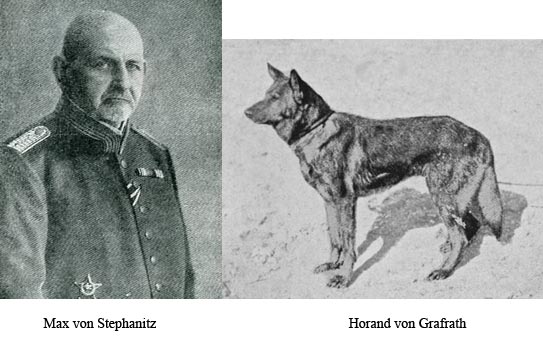
But
now, in the twentieth century, how many of our modern German Shepherd Dogs
can herd sheep? The point that I would like to make here is not only about
herding sheep. Does our present German Shepherd Dog have the ability,
attitude and willingness for it? Does the dog�s anatomy support it? Most
of our answers would be in the negative.
We all know that to herd
sheep from morning to evening, the shepherd dog must have the willingness
and attitude, with no exaggeration (in the angulation). The dog must have
firm limbs (hocks, elbows, pastern, back and shoulder) and a correct
standard size with the desired height to length proportion.
But if
we see the open class males and females from the annual conformation show
(Sieger show), we will find that many of the highly appreciated top
winning dogs/bitches cannot sustain even a day�s work. This is mainly
because some of them are oversize, extremely angulated in the rear for the
side-gait, and many of them have loose hocks.
So now, we can
literally classify the German Shepherd Dog into three categories:
1 -
Show line dogs
2 - Herding dogs
3 - Working dogs (black, bi-colour
and grey/sable)
When the breed originated, the founding stock came
from Horand von Grafrath. Also, all our present day German Shepherds have
evolved from this. Today, even though the standard has remained the same,
when we look back, we can easily segregate them into three types. The
three types look different from each other, with different breeders
following their fancies. To a great extent, the herding dogs resemble the
show line dogs.
It is rare to see any of the top champions from the
show lines competing in the working sieger or herding sieger shows.
Also, since the last forty years or more, it is rare that a working
line breeder has used a conformation show winner from the Sieger Show in
his breeding programme. And also seldom that a show line breeder has a
working champion from Bundesieger Prufung.
This year, in the
conformation Sieger Show at Ulm, it was pleasing to see working champion
Javir vom Talka Marda presenting a progeny group. This came as a surprise
to many since the working and show communities have drifted apart in
Germany. The breeders and owners have accepted that they have two types
instead of one.
Herding, which is the essence of the German
Shepherd Dog, now has few breeders and owners interested in it. The lone
warrior in Germany, as of today, is Karl Fuller from Krichental Kennel,
that is keeping the flag high for the dying sport.
From the early
development of the German Shepherd Dog, there were breeders who always
tried to do something for their fancy. For example, there was a time when
Max von Stephanitz had to warn fellow breeders not to infuse wolf blood
into the breeding. Also, post World War I, oversize dogs were noted to be
used often. A few examples of such dogs at that time were Hettel Uckermark
and Horst von Boll � both exceeded the size limits. The taller dogs were
heavier which was detrimental to their over all agility. Some of them with
narrow receding chests and weak pasterns no longer had much resemblance to
the utility dog characteristics.
At the 1925 Sieger Show,
Stephanitz chose Klodo vom Boxberg, the only medium-sized animal among
other oversize dogs, much to the surprise of the owners.
Thus,
Stephanitz demonstrated to his club members how the typical German
Shepherd Dog was expected to look and perform.
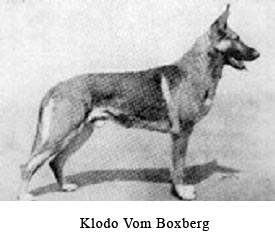
The
lesson was quickly learned. Overly large dogs were rarely seen in the
subsequent years. Surprisingly, in his time, Capt. Max von Stephanitz, had
to face challenges and opposition from different groups. But he, along
with his devout friends, stood for the ideals and vision for the German
Shepherd Dog and eventually succeeded.
In the present system, the
SV publishes the hip, elbow, size status of frequently used studs and
their progeny in SV seminars. And the chief breed warden speaks on
different sire lines, their virtues, problems and the areas where the
breeders should be careful. But the breeders and fanciers of the breed
sometimes follow their own rules of choosing stud dogs. This could either
be because of the hype for a particular stud dog, or, because of many top
breeders or breed judges having used the dog as stud, or, because of
demand/salability of particular stud�s puppies. And finally, may be camp
politics.
Let us talk about balance. This word is very often used
by novices as well as experienced breeders and judges. Balance means
stability. Stability is achieved if only all the correlated links match
with each other and create a picture of static. From static, the energy
can be developed into kinetic.
In the German Shepherd Dog, balance
means size, proportion, expression, bone strength, anatomy. So, balance is
not about finding minor faults. Rather, it is about emphasizing the
virtues and traits, and basic components of the Shepherd Dog.
Let
us now talk about size. �Our shepherd dog must be of correct size� (refer
to the FCI German Shepherd Breed Standard). I am not adverse to big dogs
but oversize dogs. Overly large size dogs do not fit into our breed. When
a correct size dog of inferior quality is compared to a slightly large,
better quality dog, I would prefer the better one.
Next comes
proportion � Proportion (as described by the standard in relation to
height-to-length ratio of the dog) - Our shepherd dog is slightly
lengthier than high, which helps the dog to trot effortlessly. A square
dog or too lengthy a dog also is a definite no-no.
When we talk
about expression, it includes secondary sex characteristics, dark eyes
(matching with the surrounding of the forehead), correct ear placement,
defined mask over-head, and is combined with dark muzzle, alert and
intelligent expression. There should be no coarseness, wrinkles on
forehead and no hanging loose lips. Too much stop has also changed the
shape of the head thus changing the shape and placement of eyes which is
detrimental to the shepherd dog expression.
Good bone strength
helps to sustain the stress and strain in the dog�s herding and working
ability.
A well-formed front is definitely an asset to our German
Shepherd Dog, i.e., tight elbows, correct brisket proportions, correct
frontline (straight line when seen from elbows to the pastern without any
deviation), correct pastern angulations.
The most important factor
is well-placed/angled/length of the shoulder blade. A well-laid shoulder
combined with right wither is of much importance in power transmission to
the front. Very high withers combined with steep shoulder blade gives a
giraffe look which destroys the balance of the dog. The dog, in such a
case, rather than having free front extensions, plows and lifts the front
leg into the air (see
photograph below).
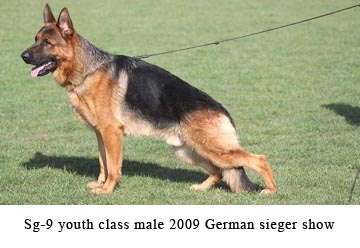
Even the chief breed warden of SV, Mr. Reinhardt Meyer, in his speeches,
has cautioned the breeders that in the present situation, withers have
become very high and it has to reduce. In the past, what was accepted as
high wither, is now being treated as normal wither. To move flat over the
ground, correct wither combined with well-laid shoulder blade is a
definite requirement.
The breed standard looks for straight and
firm back. Luckily, most of the present dogs possess that. In the
beginning of mid-nineties, there were many dogs with what we call �banana
back�/�roach back � falling down from the centre of the back (hyena dog).
It was treated as fashionable. But with this kind of back, a lot of health
problems crept in, like, more stress on hip joints and spine, diseases
like narrowing of spine and multiple sclerosis. But breeders returned to
breeding a straight back which is a welcome and healthy move for our
beloved breed.
Then comes the croup which is a highly debatable
subject. For me, the angle and width of croup is of prime importance. A
good length of croup definitely helps to create a pleasing over line. For
example, the Siberian husky breed pulls and trots the sledge cart for a
long time on the ice. If we mark the dog�s anatomy, we can find very good
shoulders with developed fore chest and right wither helps to pull the
harness. And the short back combined with powerful broad thighs coupled
with good width and angle of croup helps in strong hind thrust.
Another example here; look at this photograph of Sieger Pakros D Ulmental
below.
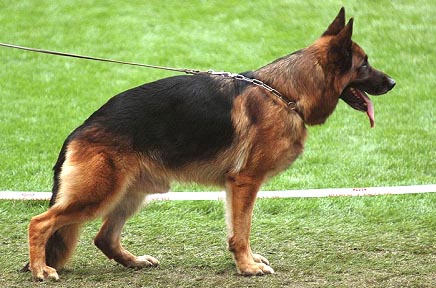
In
this picture, we can see that he definitely does not possess the ideal
croupe, but his excellent front combined with correct wither, strong rear
and good proportions, helped him to win the coveted title.
According to Chief Breed Warden Mr. Mayer, the factors which have to be
taken care of, in the future are weak pasterns, incorrect front lines,
extreme angulations in the rear, loose hocks, excess wither height, size
and coarseness of head and expression.
The present breed survey
report by SV currently emphasizes more on anatomical virtues, rather than
on working traits and nerves. Hence, Mr. Meyer stresses the need for
detailed induction of temperament and character of our shepherd in the
breed survey book.
As we know, there is more weight in the front
than in the rear. A long, moderately tucked up underline is very important
in our shepherd to create stability in movement. A dog with short
tucked-up underline creates imbalance and instability in movement. These
dogs raise their backs to balance the weight and power from behind which
creates an ugly picture.
Our beloved breed�s fanciers forget that
the German Shepherd Dog was bred to herd and work untiringly for a long
day rather than sprinting five hundred meters at breakneck speed (for
which we also have the grey hound). Running fast is not the only criteria
or what we expect from our German Shepherd. If we look back at history
(which is the biggest influence on the modern show GSD today), the young
Sieger of 1985 in Hamburg, Odin von der Tannenmeise, was the most
important successor of the Q,litter. This big (Dutch bred) dog was not the
top in gaiting (lazy); but was superior in anatomy and balance. And the
judge did not let him gait against the next four behind him (the second
was Cello Romerau and he could gait beautifully). Odin never ran fast but
walked to glory to clinch the young sieger title because of type breed
characteristics and balance.
Odin walked in the progeny group
behind Quando ...as the group came in the stadium, Odin was just amazing.
And Odin dominates the modern gene pool to this day.
So, we need
our dog to be a good walker at different speeds, with alert and
intelligent expression.
Intelligent expression is defined by
calmness, responding to the owner and handler�s voice signal, not
panicking to external factors and showing its true self. The fast gaiting
is only to evaluate the muscle conditioning and strength. But now a days,
novice youngsters want and look for German Shepherds that run fast and
people around the ring also support and cheer for the fastest. One
question that we need to ask is �Are we doing the right thing?�.
It
is sheer beauty to see a German Shepherd in an extended trot with ground
covering gait. How many top winners from this year�s open class males from
Germany can recreate the magic that Dingo vom Haus Gero and Sieger Fanto
vom Hirshel had created with their movement? Let me remind you that the
�Correct anatomy and movement of the German Shepherd Dog� video sold by SV
is the film made on Dingo vom Haus Gero. So, here we are. We are yet to
find a better specimen to replace Dingo vom Haus Gero.
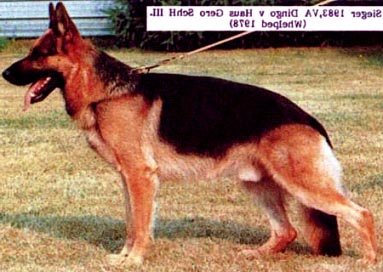
I urge our GSD fanciers and breeders to have a good look at our present
day German Shepherds and also compare them with dogs like Natz vom
Hassenborn, Mark vom Haus Beck, Fedor vom Arminius, Eiko vom Krichental.
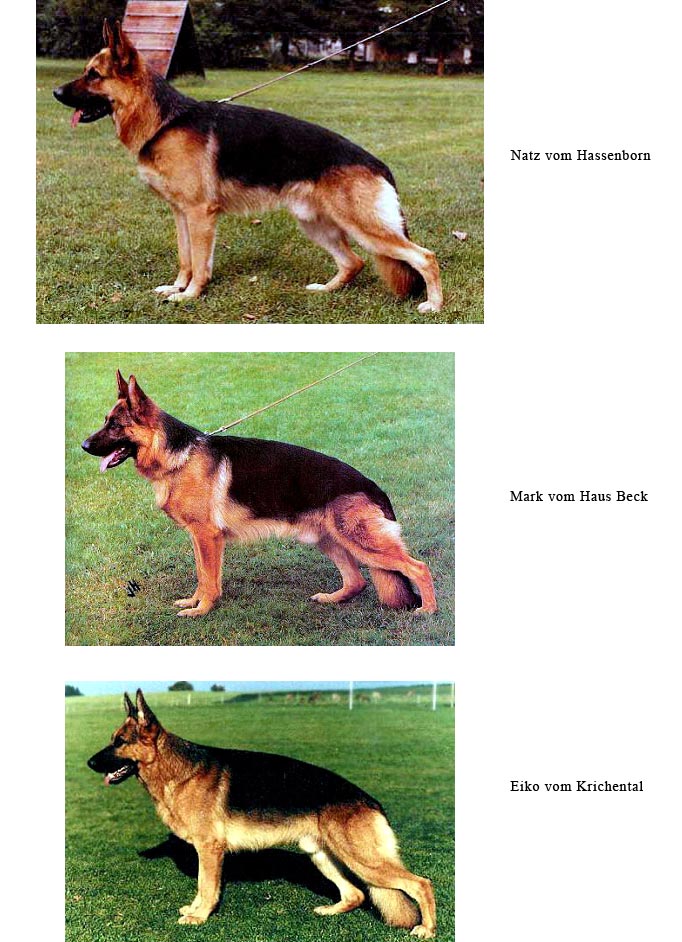
The
past truth holds good to this day � The breeding goal was, is and will
always be the �Normal Dog� as defined by the breed standard.


